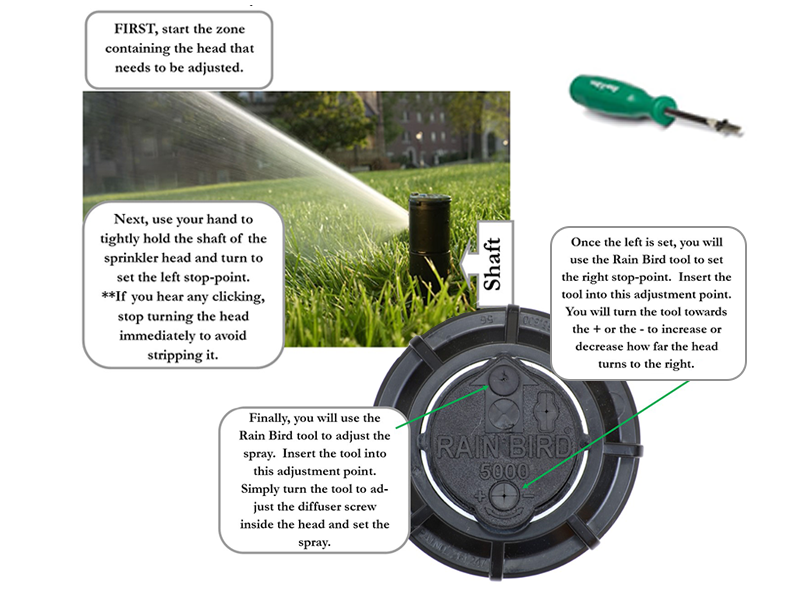Keeping your lawn and garden healthy and vibrant requires a well-functioning sprinkler system. Adjusting sprinkler heads properly is a pivotal part of lawn care, ensuring that water is distributed efficiently and effectively. Whether you are tweaking the system for the first time or making seasonal adjustments, understanding how to manage your sprinkler heads can make a significant difference in your landscape’s appearance and water usage.
From altering the spray radius to maintaining the entire system, this guide will provide you with top tips for success. So, grab your tools, and let’s dive into the world of sprinkler adjustments!
How do you adjust the spray radius on a sprinkler head?
Adjusting the spray radius of a sprinkler head is crucial for ensuring that water reaches all parts of your garden without wastage. To begin, identify if your sprinkler head has a screw or dial for adjustments. Turn the screw clockwise to decrease the radius or counterclockwise to increase it. For dials, simply twist in the desired direction following the manufacturer’s guidance.
Remember that each sprinkler model might have its specific adjustment method; therefore, consulting the user manual is a wise first step. For example, gear-driven rotor heads might require a special tool for adjusting the radius. Take care not to over-tighten any components, as this can cause damage.
Adjustment should always be done when the system is off to prevent injury and to allow for more precise settings. After adjusting, run the system to check the coverage and make any necessary fine-tuning. This ensures that each plant receives the right amount of water – not too much or too little.
What are the different types of sprinkler heads?
Sprinkler systems come with a variety of head types, each designed for specific landscaping needs. The three main types of sprinkler heads are pop-up, rotor, and impact heads.
Pop-up sprinkler heads are ideal for residential lawns and gardens as they retract into the ground when not in use, reducing the risk of damage from lawnmowers. Rotor heads, on the other hand, are perfect for covering large areas as they rotate streams of water around the landscape. Impact sprinkler heads are known for their distinctive clicking sound and are highly adaptable, offering adjustments for both distance and pattern.
Each type of sprinkler head is suited to different water pressures and landscape layouts. Understanding the unique attributes of your sprinkler heads is essential for effective watering and can greatly impact your system’s efficiency.
How to adjust a pop-up sprinkler head?
When adjusting a pop-up sprinkler head, begin by locating the adjustment screw. Turning this screw will alter the distance the water is sprayed. You may also need to adjust the arc or the direction of the water. This is usually done by rotating the entire stem or a specific part of the head.
For accurate adjustments, it’s often necessary to make incremental changes and observe the results. Be gentle when handling the heads to avoid damaging the riser. Pop-up sprinkler heads can be delicate and may require careful attention to detail.
If the head is not fully popping up or retracting correctly, it may be a sign of debris in the nozzle or a need for replacement. Regular cleaning can help prevent these issues and ensure optimal performance of your pop-up sprinkler heads.

How to adjust a rotor sprinkler head?
Rotor sprinkler heads are known for their long-range and even water distribution. To adjust a rotor head, locate the adjustment screw or mechanism which controls the arc and distance. Use a small flathead screwdriver or a rotor tool specifically designed for your sprinkler model.
Adjust the arc by turning the adjustment screw; some models may require you to lift the head and rotate it physically. Be mindful that changes to the arc will affect the overall coverage, so fine-tuning is often necessary.
As with pop-up heads, ensure that the system is off while making adjustments to prevent injury from the moving parts. It is also advisable to check the manufacturer’s guidelines for specific instructions regarding your rotor sprinkler head model.
How to adjust an impact sprinkler head?
Impact sprinkler heads are durable and ideal for uneven terrains. To adjust the spray pattern on an impact sprinkler, move the diffuser pin in or out. This pin will break up the water stream, effectively changing the distance of the spray.
You can also adjust the arc by rotating the small metal tabs located on the head. Carefully bend these tabs to modify the spray pattern to fit your lawn’s needs. To change the direction of the spray, simply rotate the entire sprinkler body in its base.
Impact heads may require more frequent maintenance due to their exposed moving parts; however, their versatility and adaptability make them a popular choice for many gardeners.
How many sprinklers per zone: Top 5 tips for success?
- Calculate your water pressure and flow rate to determine how many sprinkler heads can be efficiently operated in one zone.
- Use the manufacturer’s specifications to understand the optimal coverage for each sprinkler head and plan accordingly.
- Consider the layout of your garden, including plant types and terrain, to maximize the effectiveness of each sprinkler head.
- Balance the system by ensuring that each head is receiving an adequate amount of water pressure for uniform coverage.
- Regularly inspect your system for leaks or blockages, which can affect how many sprinklers can function in a single zone.
Understanding the capacity of your watering system and the needs of your landscape will guide you in determining the ideal number of sprinkler heads per zone.
What are the common mistakes to avoid when installing sprinklers?
- Avoid placing sprinkler heads too close or too far from each other, leading to dry spots or water overlap.
- Do not mix sprinkler head types within the same zone, as they distribute water at different rates.
- Never ignore local water regulations and permits required for sprinkler installation.
- Skipping regular maintenance checks can result in unnoticed damage and inefficiency.
- Forgetting to winterize your system in cold climates can lead to frozen pipes and broken sprinkler heads.
These common installation errors can be costly and counterproductive. Avoid them for a successful sprinkler system setup.
How to maintain your sprinkler system for optimal performance?
Maintenance is key to any sprinkler system’s longevity. Begin by scheduling regular inspections to identify any issues early on. Replace worn or broken parts immediately to prevent further damage to the system.
 Best companion plants for peppers: herbs, flowers and veg to grow alongside peppers
Best companion plants for peppers: herbs, flowers and veg to grow alongside peppersAt the start and end of the watering season, perform a thorough check-up. Clean out the filters, check for leaks, and make sure the heads are not obstructed by grass or debris.
Adjusting your sprinkler system for the changing seasons is also important. Make sure to adjust the watering schedule based on seasonal rainfall and temperature variations.

Lastly, consider investing in a smart controller that can automatically adjust watering based on weather conditions, further optimizing your system’s performance and conserving water.
For a visual guide on adjusting sprinkler heads, consider watching this informative video:
Related Questions on Sprinkler System Adjustments
How do you adjust the spray radius on a sprinkler head?
To adjust the spray radius, locate the radius adjustment screw on the sprinkler head. Turning it clockwise will reduce the spray distance, while turning it counterclockwise will increase it. Always make small adjustments and test the spray pattern until you achieve the desired coverage.
For rotor and impact heads, you might need to use a special adjustment tool provided by the manufacturer. Ensure that the adjustments are made when the system is off to prevent injury.
What are the different types of sprinkler heads?
The main types include pop-up, rotor, and impact heads. Pop-up heads are suitable for smaller residential lawns, rotor heads are designed for larger and more open areas, and impact heads are great for adjustable, far-reaching irrigation. Each type offers different benefits, such as ease of maintenance and adaptability to water pressure.
Choosing the correct type of head for your specific irrigation needs is critical to efficient water distribution and the health of your landscape.
How to adjust a pop-up sprinkler head?
Begin by locating the adjustment screw on the top of the head. Turning this screw will alter the water flow and distance. To adjust the spray pattern, rotate the stem or collar of the head. Some models may also have an arc adjustment feature that allows you to define the left and right boundaries of the sprinkler’s reach.
Pop-up sprinkler heads are often found in residential settings and require regular maintenance to function properly, including cleaning and occasional replacement of worn parts.
How to adjust a rotor sprinkler head?
Rotor heads are adjusted by using a flathead screwdriver or a brand-specific tool to modify the arc and radius. These adjustments are made by turning screws located on the head. It’s important to follow the manufacturer’s instructions for your particular model to ensure correct adjustment.
Regular maintenance of rotor heads is essential, as they are prone to blockages from dirt and debris.

How to adjust an impact sprinkler head?
Adjusting an impact sprinkler involves setting the diffuser pin and adjusting the metal tabs to control the spray pattern. The direction of water can be changed by rotating the barrel of the head. Impact heads are known for their durability and are well-suited for gardens with irregular shapes.
To ensure optimal performance, it’s important to periodically check for any obstructions in the nozzle area and to clean the head as necessary.
How many sprinklers per zone?
The number of sprinklers per zone depends on various factors including water pressure, flow rate, and the specific needs of your landscape. A balanced design ensures that each head receives enough water to operate efficiently. Utilize manufacturer guides and professional advice if needed, to determine the optimal number of heads per zone.
Regular evaluation of your sprinkler placement and performance can help you decide if adjustments are needed to the number of sprinklers in each zone.
What are the common mistakes to avoid when installing sprinklers?
One should avoid overspray onto non-landscaped areas, not considering the water pressure, and neglecting local installation codes and regulations. Also, incorrect spacing between heads can lead to uneven watering. Be aware of these potential pitfalls to ensure a successful installation.
How to maintain your sprinkler system for optimal performance?
Maintenance involves regular checks for leaks, cleaning filters, and adjusting sprinkler heads. Seasonal adjustments are also crucial to cater to changing weather and landscape growth. An optimally maintained system saves water and keeps your lawn looking its best.
 How to grow a peach tree from a pit: tips for planting stone fruits
How to grow a peach tree from a pit: tips for planting stone fruitsInvesting time in proper maintenance can prolong the life of your sprinkler system and ensure it operates at peak efficiency.

